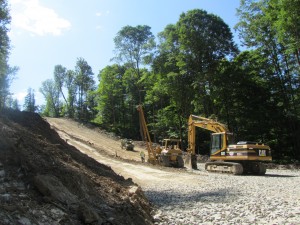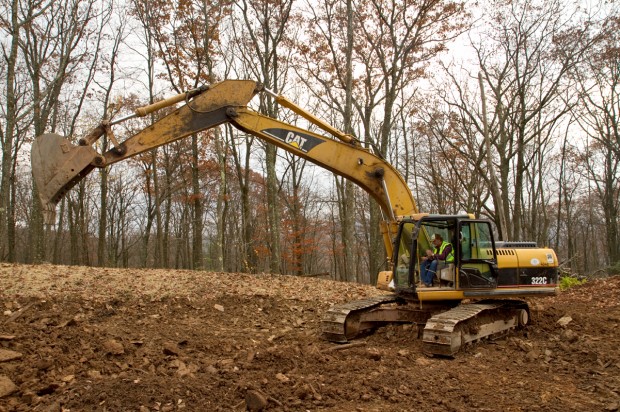Pipelines: The new battleground over fracking
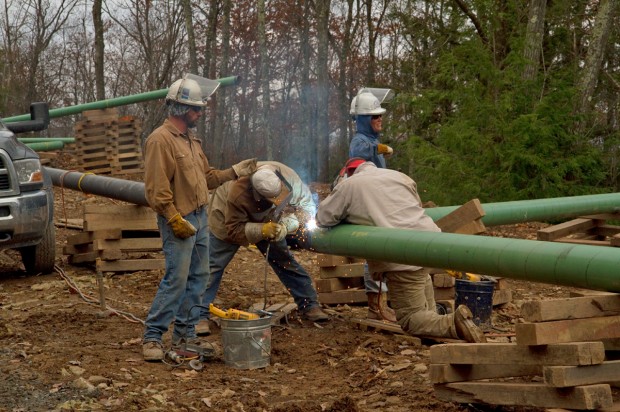
Lindsay Lazarski / WHYY
Crews weld a pipeline connecting to a natural gas well in the Loyalsock State Forest.
Forget the battles over the Keystone XL. Pipeline wars are now raging in Pennsylvania, where production is high and pipeline capacity is low. Marcellus Shale gas has the potential to alter the landscape of the global energy market. But right now a shortage of pipelines to get gas from the gas fields to consumers has energy companies eager to dig new trenches. And activists opposed to more drilling see pipeline proposals as the new battleground over fracking.
Pennsylvania’s pipeline building boom could expand the nations’ and perhaps the world’s, supply of natural gas. And this boom includes an estimated 4,600 miles of new interstate pipes, tunneling under Pennsylvania’s farms, wetlands, waterways, and backyards. That’s on top of 6800 miles of existing interstate natural gas pipes, according to the Energy Information Administration.
Drillers eager to reach new markets are frustrated right now, because there’s just not enough room in the current pipeline system to transport their gas beyond regional markets.
“That gas languishes and it builds up and now that price will drop,” said Rob Boulware, a spokesman for Seneca Resources.
Today, Marcellus Shale gas sold at less than $2/MMBtu, which is about a dollar lower than gas sold in other parts of the country.
While producers and utilities try to expand their infrastructure, the pipeline construction boom has run up against opposition in small towns and rural areas where environmentalists and residents are pushing back. Some opponents simply don’t want their land disturbed, or taken by eminent domain. But other activists see pipelines as part of a larger mission to end drilling altogether.
“The pipelines are being built in order to induce more drilling and fracking,” said Maya van Rossum with the Delaware Riverkeeper Network. “And of course more drilling and fracking results in the need for more pipelines. So the two are inextricably intertwined and if you oppose one, truthfully, you have to oppose the other.”
Too many molecules, too little pipe
Luke Jackson is an analyst with Bentek Energy, a firm that specializes in natural gas. Jackson says that just 5 years ago, the Marcellus Shale, which is made up primarily of Pennsylvania’s gas fields was producing two billion cubic feet of gas a day. Today that’s jumped to 19 billion cubic feet every day. And he predicts, in just 4 years, there will be 30 billion cubic feet of gas coming out of the region. That’s a 1400 percentage rise in just 10 years.
“There’s so [many] molecules out there, whether its gas, whether its oil, whether it’s natural gas liquids, you just have a ton of supply on the market at the moment,” said Jackson.
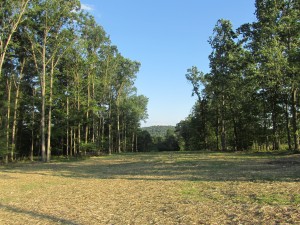
A clearing shows the site of a pipeline, one of many running beneath Pennsylvania's farms, forests and waterways.
And that massive supply is too much for the current system of pipelines to carry. There’s a traffic jam of gas molecules in the pipeline system.
Seneca Resources is a natural gas driller, one of the many trying to expand their number of customers by delivering gas to new markets. Their spokesman Rob Boulware says demand for new pipes to carry all that gas, and to ease the traffic jam, are so high, the new routes for that gas is already sold out. And some of those pipelines won’t come online for another couple of years.
“Think of it like a turnpike that no one is driving on but people are lined up at the gate to go through it,” said Boulware.
Seneca Resources is banking on a newly approved pipeline that will carry its gas up through New York, and then further into Canada, where it could fetch a higher price. And this is a complete reversal from five years ago, when the eastern part of the U.S. was importing Canadian gas. Several older pipelines, built decades ago to bring natural gas from the Gulf of Mexico up to the northeast have reversed their flow. Today, instead of flowing from the south, the gas flows from the Marcellus region in Pennsylvania down, as far away as Florida, and west to Chicago. Pennsylvania already has about 6,800 miles of existing pipelines. But these pipes still are not enough to handle all of the state’s gas.
“When you look at the [gas production] averages in the southwestern corner and the average daily production in the northeastern part of Pennsylvania, you see these wells are blowing at incredible numbers,” said Seneca’s Boulware. “And if you have ten of those wells on a pad then you’re really sending a lot of gas into the market or have the potential to.”
Some of these Pennsylvania wells are producing 50 times more gas than a conventional well produced in the state only ten years ago. So plans for new pipelines are in the works to ship natural gas from Northeast Pennsylvania down to an export terminal in Maryland. And from there, Pennsylvania’s gas would ship to Japan, where customers are willing to pay four times the current price.
New pipelines will also be taking the gas up to New York and Boston, where residential customers pay more than those in Pennsylvania. Some of that Marcellus gas could get shipped overseas through a planned export facility in Nova Scotia.
Turning Philly into an “energy hub”
There’s also a plan by business leaders to build a pipeline from northeast Pennsylvania down to Philadelphia to supply a potential manufacturing renaissance in the city.
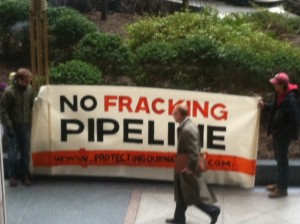
Susan Phillips / StateImpact Pennsylvania
Environmentalists in downtown Philadelphia urged the U.S. Army Corps of Engineers to halt a controversial pipeline project in Northeast Pennsylvania.
The guy behind that plan is Phil Rinaldi. He’s the CEO of Philadelphia Energy Solutions, which took over some refining operations several years ago in the city. Rinaldi sits on an ad hoc committee trying to turn Philadelphia into an energy “hub” – a place where brokers could haggle over the price of natural gas. And Rinaldi has an even grander idea. He wants the city to revive its past industrial might by attracting large factories that would use the state’s cheap gas to churn out products.
But here’s the problem, when Rinaldi called the city’s gas utility, Philadelphia Gas Works, to ask how much cheap Pennsylvania-made shale gas he could rely on, he didn’t get the answer he expected.
“The answer was an unequivocal none,” said Rinaldi. “You understand none. So that’s the status in Philadelphia. All of the delivery systems are absolutely full. The gas is abundant and we can’t get it because the highways are clogged.”
Winners and Losers in the pipeline battle
For the most part, the growth in new natural gas markets is with the kind of commercial clients that Rinaldi is trying to lure to Philadelphia. Those include manufacturers and electric power plants. Prices have been trending down overall. But the average residential consumer of natural gas has not seen a bonanza. Those who have, are those who have switched from oil heat to natural gas.
Dave and Nichole Kang did just that last year and they say it’s made a big difference, especially with a new baby.

Susan Phillips / StateImpact Pennsylvania
Dave and Nichole Kang reduced their heating bills from $2000 a year to $500 after switching from oil to natural gas.
“It’s a huge burden off,” said Dave Kang. “It’s relatively easier to budget for and we definitely have more money to put elsewhere.”
The Kangs reduced their yearly bill from about $2000 down to about $500, which has changed how they heat their home.
“I don’t think there’s any hesitation now to just be like, oh turn the heat up,” said Kang. “And its ok, its no big deal.”
But environmentalists say residential customers like the Kangs aren’t the ones that will actually benefit. The Delaware Riverkeeper Network’s Maya van Rossum says that’s because some of the new pipelines will ship the gas to more lucrative markets abroad.
“It really is about creating more gas that can be exported overseas to foreign nations because the drilling companies can sell this gas at three or four times the amount in other countries.”
The arbiter in these pipeline disputes is the Federal Energy Regulatory Commission, or FERC. The FERC chairman Cheryl LaFleur recently spoke at the National Press Club in Washington in support of pipeline expansion. LaFleur says natural gas is needed to replace coal in order for the U.S. to meet its climate goals. But LaFleur knows that pipelines have become a battle zone.
“Pipelines are facing unprecedented opposition from local and national groups including environmental groups,” said LaFleur.

